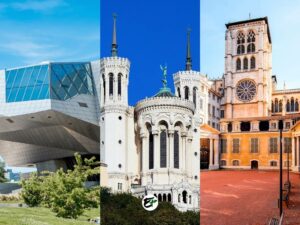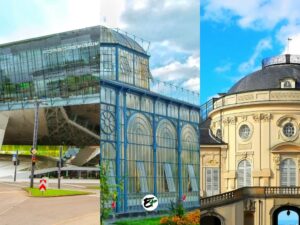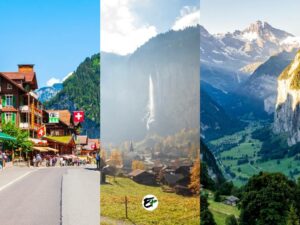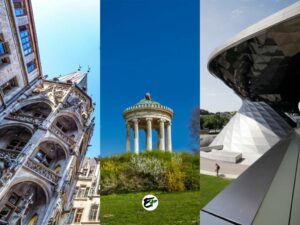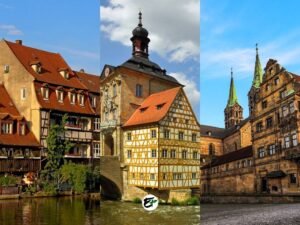Visiting Rocamadour: A Guide to the Top 10 Must-Do Activities
Long before the rise of the international tourism industry, there were already destinations in France that welcomed countless travelers.
Some were even visited by monarchs from other kingdoms! One of these places is Rocamadour. Its church (Basilique Saint-Sauveur et crypte Saint-Amadour), a part of the pilgrimage Routes of Santiago de Compostela, drew innumerable pilgrims from different parts of Europe since the 11th century.
Today, Rocamadour is considered one of the most beautiful villages in France and it is packed with beautiful experiences: Cité Médiévale, Rocher des Aigles, Parc Durandal, and Gouffre de Padirac are among the best ones to see and try. This preserved medieval village is worth visiting not only for its religious and cultural importance, but also for its quaint scenery, spectacular animals, and natural attractions.
These highlights I’ve mentioned are just a glimpse of why Rocamadour is such a fantastic destination. In this post, I’ll provide a detailed exploration of each one.
This post contains affiliate links. I may receive a tiny commission at no additional cost to you.
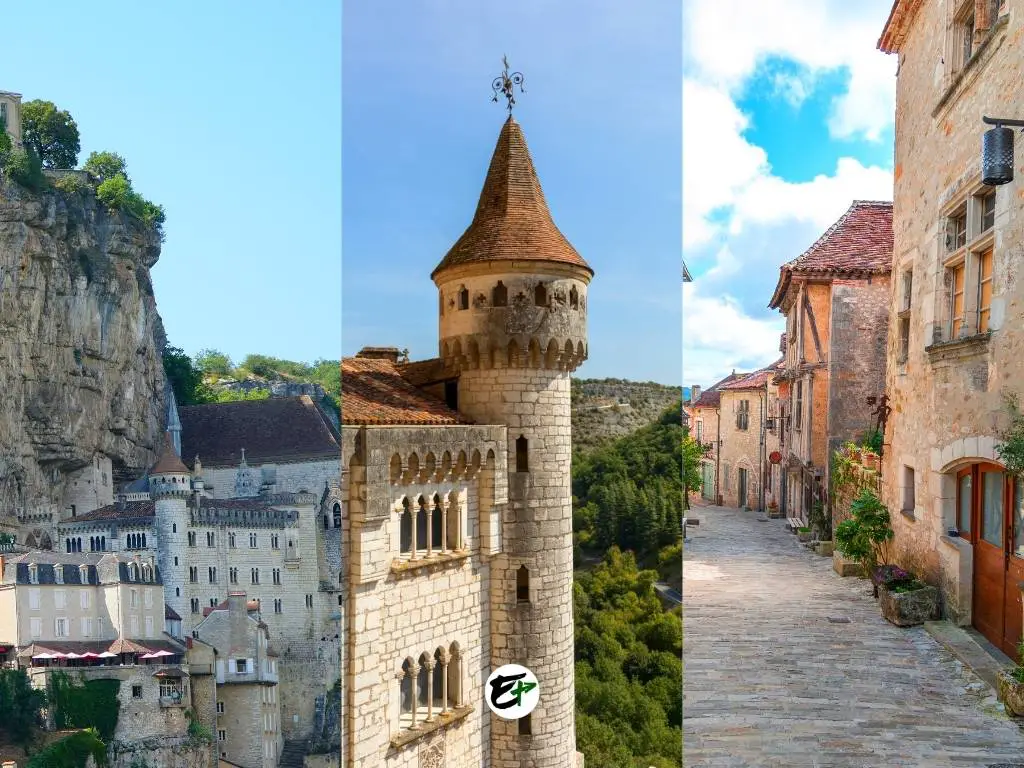
Use the table of contents to skip to topics.
Good to know: By the end of this article, you should have discovered why Rocamadour is so famous and what fascinating discoveries await you in this place. The different attractions and fun experiences in Rocamadour are also detailed in this post. Practical information is included as well!
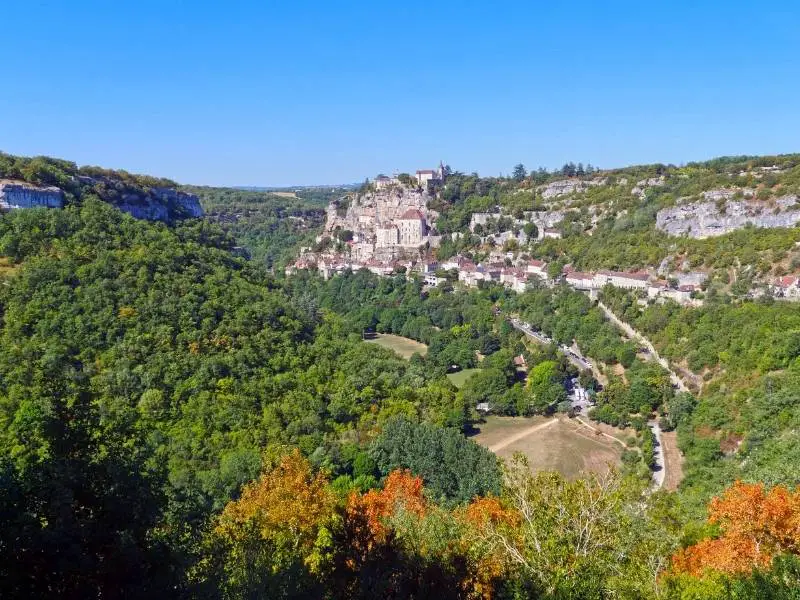
While it’s easy to see why everyone should consider visiting Rocamadour, given the scenes that seem straight out of a fantasy novel, a visit to Rocamadour is more than just sightseeing. Especially if you are a Catholic like me, it becomes a profound journey. Allow me to walk you through each reason that makes Rocamadour a must-visit destination, beginning with its cultural importance.
If you need a place to stay in Rocamadour, you can find the best hotel deals in Rocamadour here.
1. Join the Pilgrimage to Rocamadour — a Remarkable Tradition
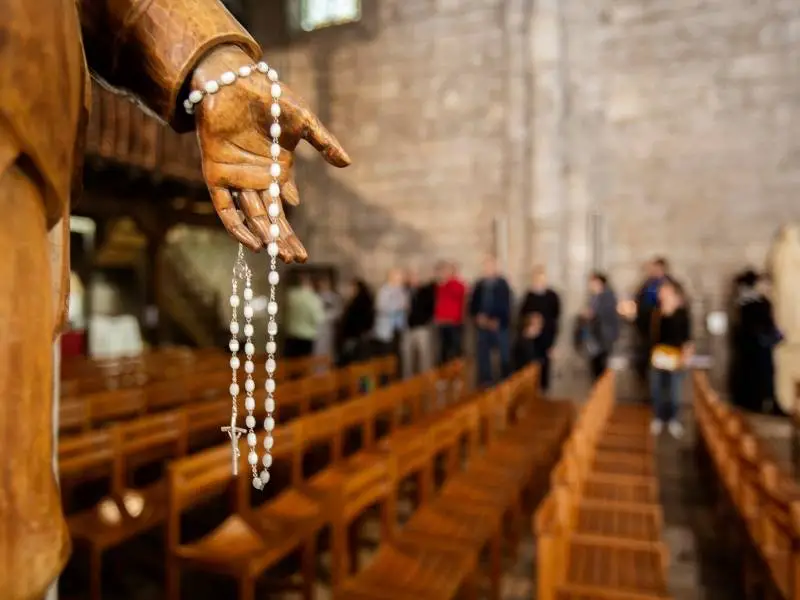
Rocamadour is notable for being more than just an ordinary pilgrimage site. In the Middle Ages, it was one of the four holy “pillars of Christendom”. And the other three were Jerusalem in Israel, Rome in Italy, and Santiago de Compostela in Spain.
The religious significance of Rocamadour dates back to the 4th century. This was when Amadour, a hermit now recognized as a saint, journeyed to the Alzou Valley in Quercy to spread the Gospel. Quercy is the historical region where modern-day Rocamadour is located.
Centuries later, Christianity became a well-established religion in Quercy. Churches were built across the region. And locals have witnessed miracles performed by the Black Madonna — the sculpture of the Virgin Mary has made Rocamadour well-known far and wide.
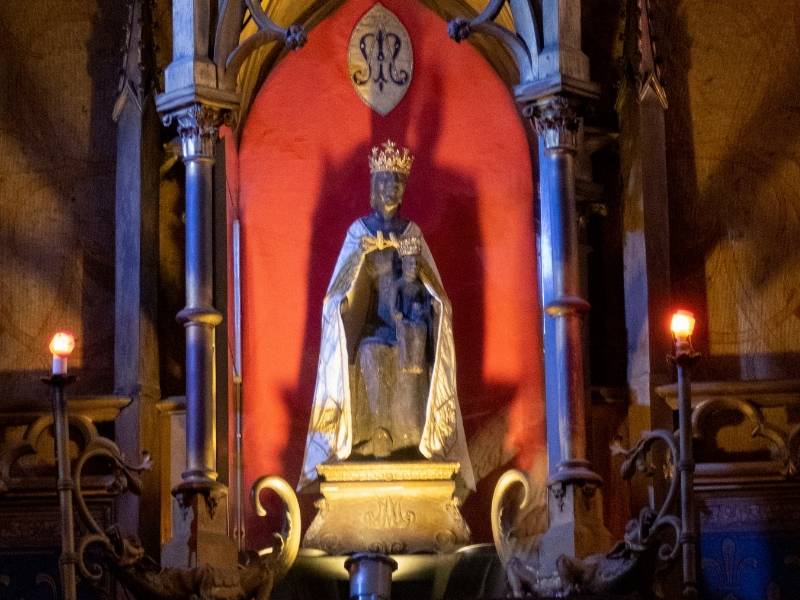
The rumors about the miraculous Black Madonna of Rocamadour spread all over Europe, drawing countless pilgrims.
After the year 1166, the number of Christians visiting Rocamadour increased. This was the year when the remains of Saint Amadour were discovered, buried in front of the sanctuary of the miraculous Virgin Mary, in the Notre Dame chapel. Interestingly, the remains of Saint Amadour were well-preserved.
This is where Rocamadour got its name. Roc (the village built on a giant rock) + Amadour.
Although Saint Amadour’s relics are still in his 12th-century crypt, the original form of the remains found in 1166 no longer exists. Unfortunately, it was destroyed by the Protestants, along with some parts of Rocamadour, during the Wars of Religion.
Past conflicts may have destroyed significant relics and churches, but the spirituality in Rocamadour remains. If you are a believer, this is one of many reasons to visit Rocamadour.
Despite its evolution into a tourist attraction, Rocamadour continues to attract pilgrims. You can join them in this notable tradition that has existed for nearly a millennium if you like. As a Catholic, I consider it a privilege to participate in this pilgrimage.
Did you know that even kings and queens of France, England, and Castile, such as Henry II, Louis IX, Charles IV, and Blanche, made a pilgrimage to Rocamadour? Visit Rocamadour and venerate the Black Virgin in her chapel. You may be granted the miracle you’ve been longing for.
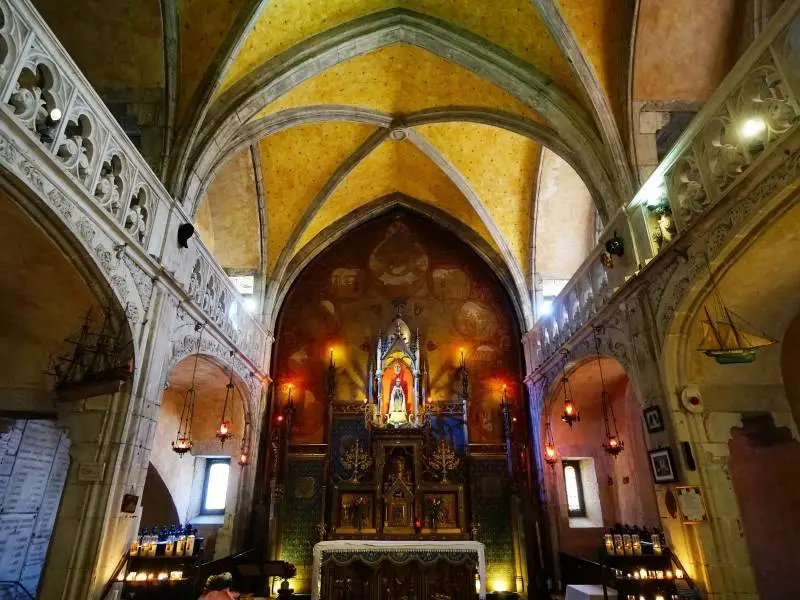
Did you know that France was once the center of Christendom? During the 14th century, popes resided in Avignon. I recommend discovering the beautiful historical city of Avignon and its Palais des Papes. The Palais des Papes is the largest gothic palace in Europe.
2. Explore Rocamadour’s Sanctuaries — Religious Medieval Marvels
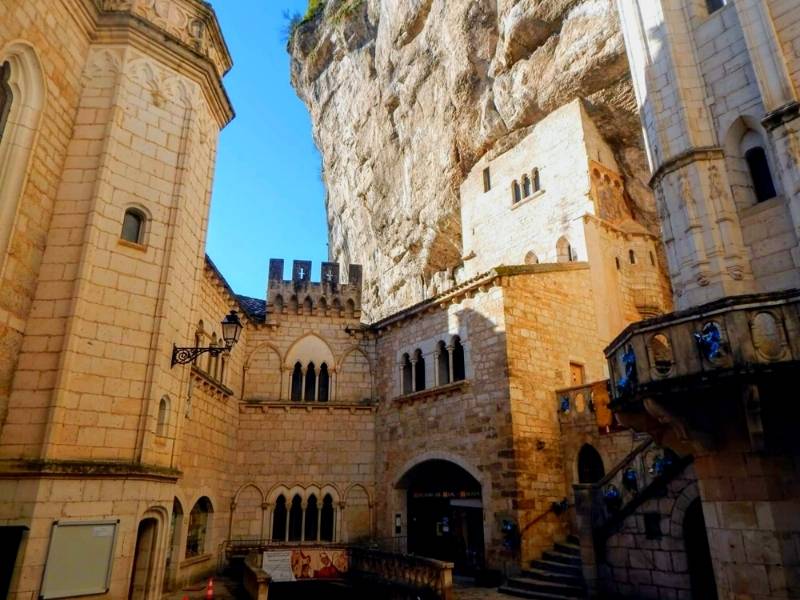
What’s fascinating about Rocamadour is the relationship between Saint Amador, the founder of Christianity in Rocamadour, and the Black Madonna, the miraculous figure that has made Rocamadour famous. Saint Rocamadour carved the Black Madonna.
By the way, the Black Madonna is a sculpture carved out of walnut wood. It is located in the Notre-Dame Chapel, which is part of the Sanctuaries.
The Sanctuaries are the spiritual heart of Rocamadour. They contain the Notre-Dame Chapel, along with a few other chapels. The names of these chapels in the Rocamadour Sanctuaries are as follows:
- Chapel of Notre-Dame de Rocamadour (Notre Dame Chapel)
- Chapelle Saint-Michel (Saint Michael Chapel)
- Chapelle Saint-Louis (Saint Louis Chapel)
- Chapelle Saint-Jean-Baptiste (Saint John Baptist Chapel)
- Chapelle Saint-Blaise (Saint Blaise Chapel)
- Chapelle Saint-Anne (Saint Anne Chapel)
- Basilique Saint Sauveur (Saint Sauveur Basilica)
The main attraction, and indeed the holiest, is of course, the Notre Dame Chapel. Although it was destroyed in the past, it was rebuilt to its previous appearance in 1479.
The Saint Sauveur Basilica, however, is the largest chapel.
Rocamadour’s Sanctuaries are not just a historical pilgrimage site. They are also a reason to visit Rocamadour for their architectural beauty, intriguing artworks, and outstanding civil engineering.
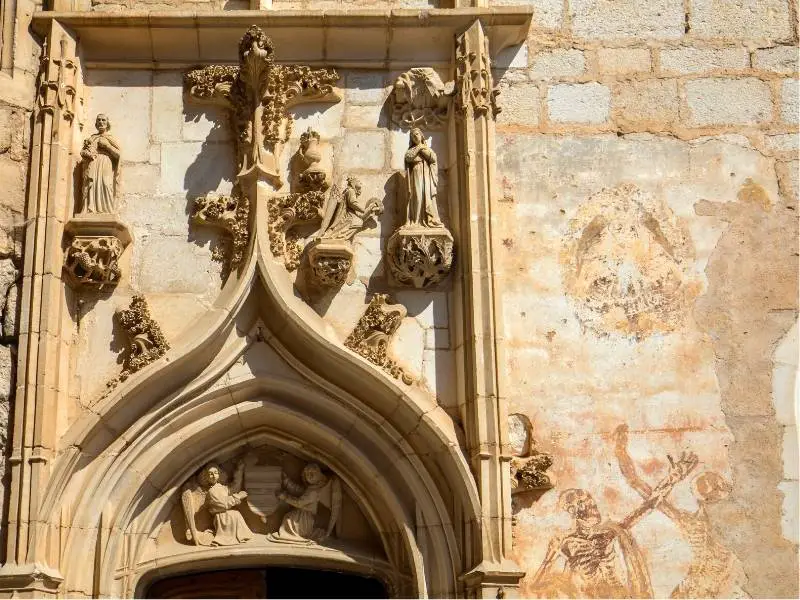
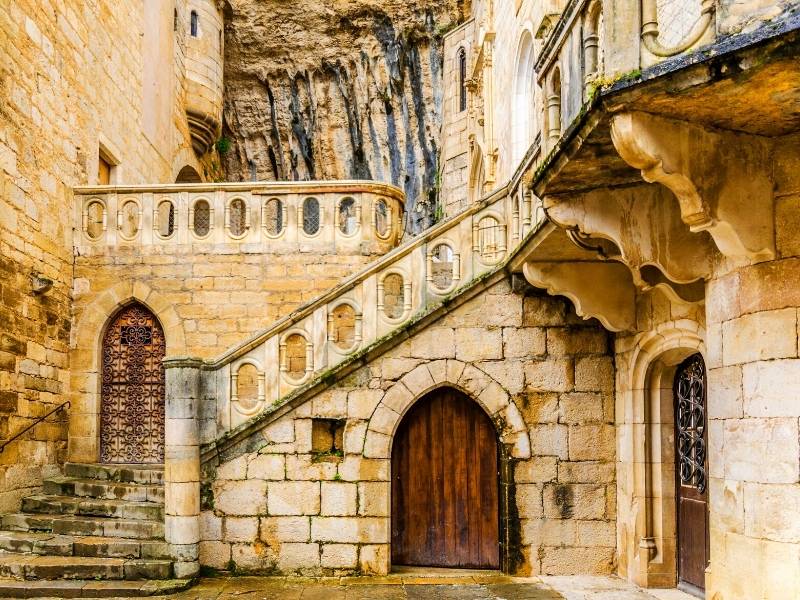
Considering that the Sanctuaries were built below a cliff using primitive construction methods, it’s hard to imagine the amount of work and calculation that went into creating something so enduring.
As someone who studied statics during my engineering college days, I was amazed by the Rocamadour Sanctuaries and their builders.
However, a deep understanding of statics and physics is not necessary to fully appreciate the Sanctuaries. You can simply stand in the middle of the parvis, look around, and be filled with awe by its mere appearance.
Here are the 360-degree images of the Sanctuaries (try to swipe the image to see more parts):
First level
Second level
The parvis of Rocamadour Sanctuaries can make you feel as if you’re in a castle courtyard. It features gothic stucco works, frescoes, beautiful iron gates, crenellations, and elements that can transport visitors’ imaginations back to the distant past.
To the west of the parvis, you’ll find the staircase leading to the Notre-Dame Chapel. Across from the Notre-Dame Chapel, you’ll see the pathway to the Sanctuaries’ balcony.
The balcony of the Sanctuaries is one of the unmissable places to visit in Rocamadour. Why? Because it offers a scenic view of the Alzou valley and the Sanctuaries’ witch-hat turret. Indeed, it’s the perfect spot to capture a photo souvenir or selfie in Rocamadour.

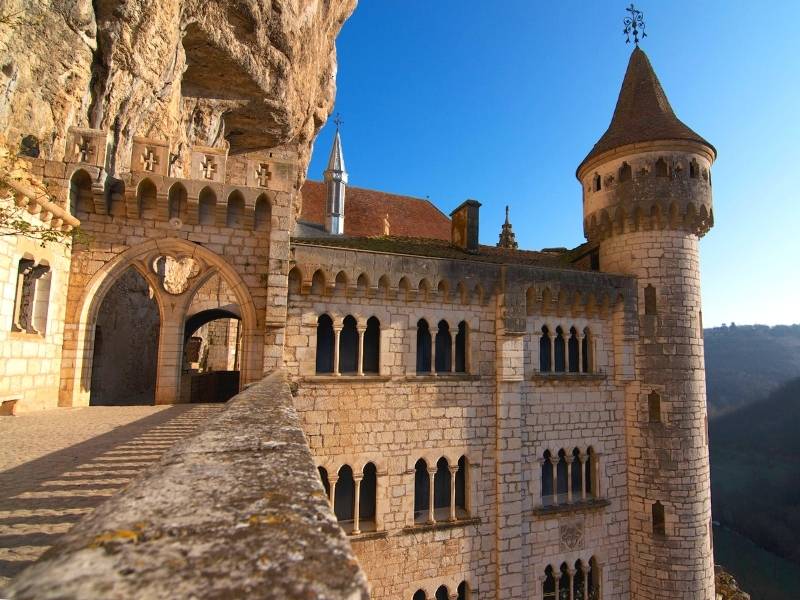
Churches and chapels dating back to medieval times are indeed marvelous works of art! One of the most beautiful churches you must see is the Sainte-Chapelle in Paris. The beauty of its stained-glass windows is indescribable.
3. Locate Rocamadour’s Little Gems — Legendary Objects, Fascinating Tales

When you reach the parvis of Rocamadour’s Sanctuaries, don’t rush to the balcony. I understand the excitement of seeing phenomenal views and the witch-hat turret! However, you should not miss discovering the fascinating legendary item in the parvis.
The legendary item, known as the Durandal Sword, may not appear spectacular, but the story behind it is part of Rocamadour’s magical experience—another reason why you should visit this sacred village. The Durandal Sword can be found puncturing the rocky cliff wall above the portal of Notre Dame chapel at the second level of the parvis.
Legends say the Durandal Sword was a God-given weapon to defend France from invaders. When Saracens invaded France, the swordbearer named Roland used the Durandal Sword to drive off 400,000 enemy soldiers. Knowing he would be captured by the enemy, Roland prayed to the archangel Michael. He wished for the sword to be cast somewhere the enemies couldn’t reach, so it could not be used against France. Miraculously, the Durandal Sword flew hundreds of kilometers away from the battlefield and landed at the cliffs of Rocamadour.
The priests and locals of Rocamadour may have just made up the story. But isn’t it a good story to ponder while exploring Rocamadour?
4. Wander Through Rocamadour’s Medieval Village — The Sacred Way
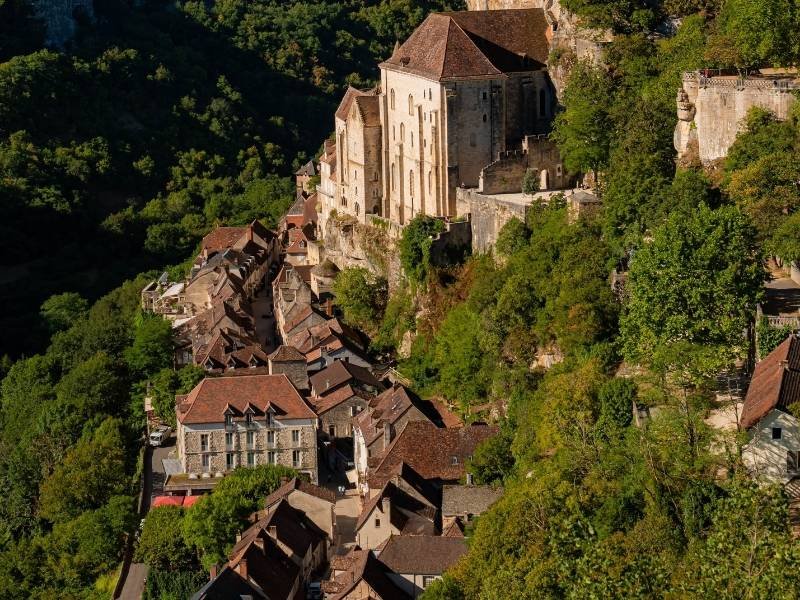
What makes Rocamadour worth visiting for not only Catholics and Christians? It’s Rocamadour’s medieval village, or Cité Médiévale. The quaint houses, cobblestone lanes, arches, and additional buildings on the hillside of Rocamadour will have you on a picture-taking spree!
But it’s not just the Sanctuaries and Cité Médiévale that are the attractions. Rocamadour also boasts a palace, another hamlet known as l’Hospitalet, and even animal parks. We will discuss each of these as we go along.
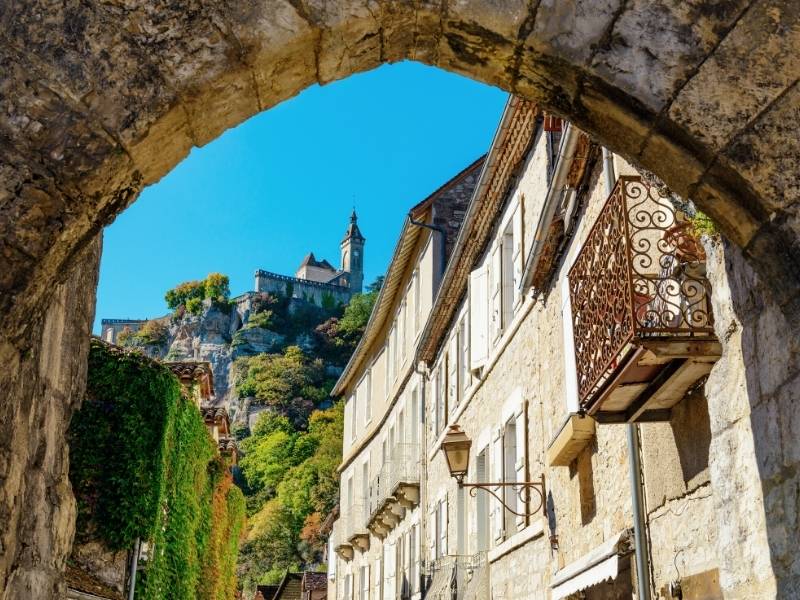
For now, let’s focus on Rocamadour’s medieval village, Cité Médiévale. But first, here are some maps to give you an overview of the attractions in Rocamadour:
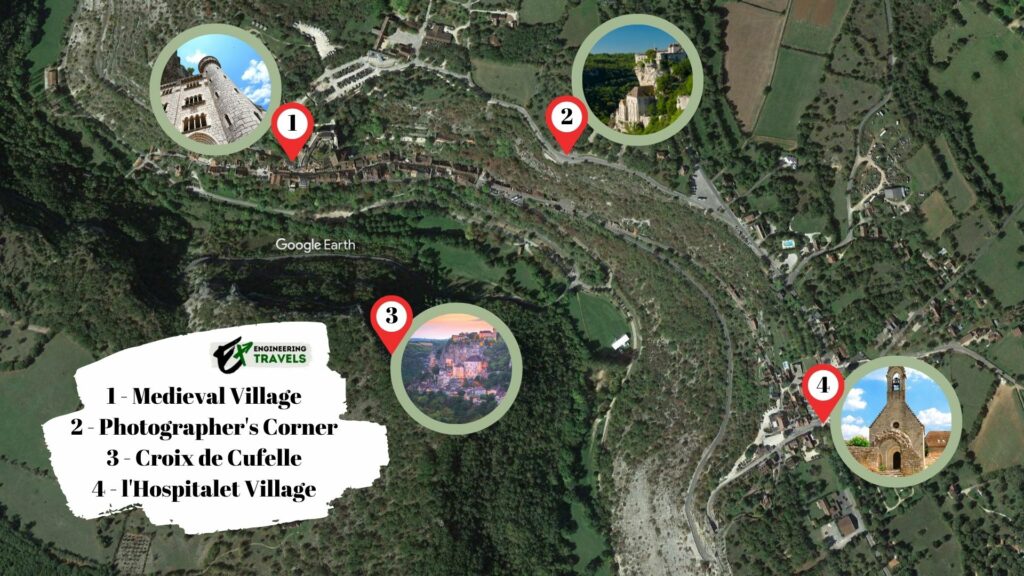
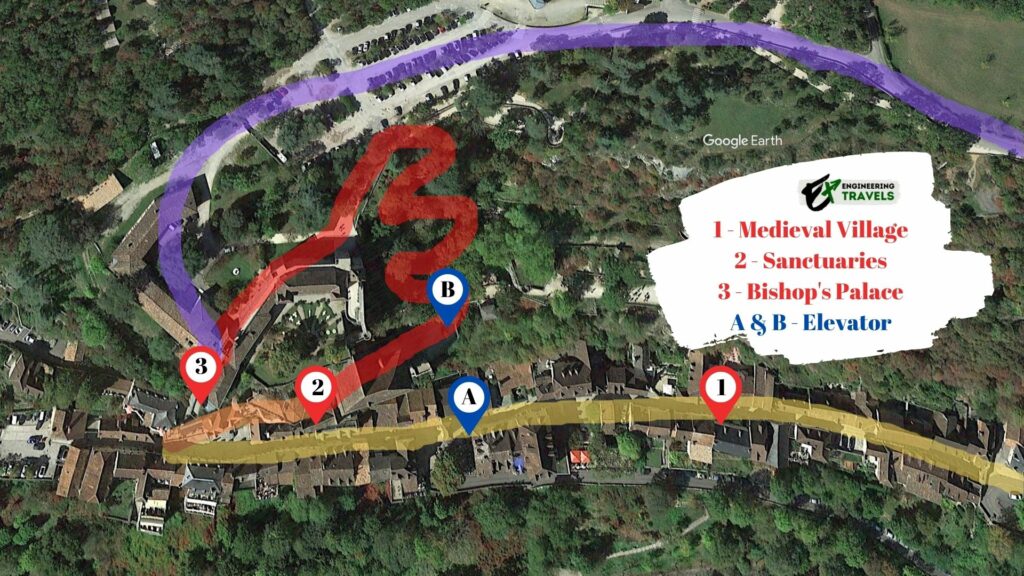
Note: The highlighted long line indicates the route to see the main attractions in Rocamadour, specifically the Cité Médiévale portion. Here’s more information about the line highlights:
- Yellow: Cité Médiévale main street
- Orange: Grand Staircase
- Red: The Chemin de Croix (Way of the cross)
- Purple: Way back to l’Hospitalet
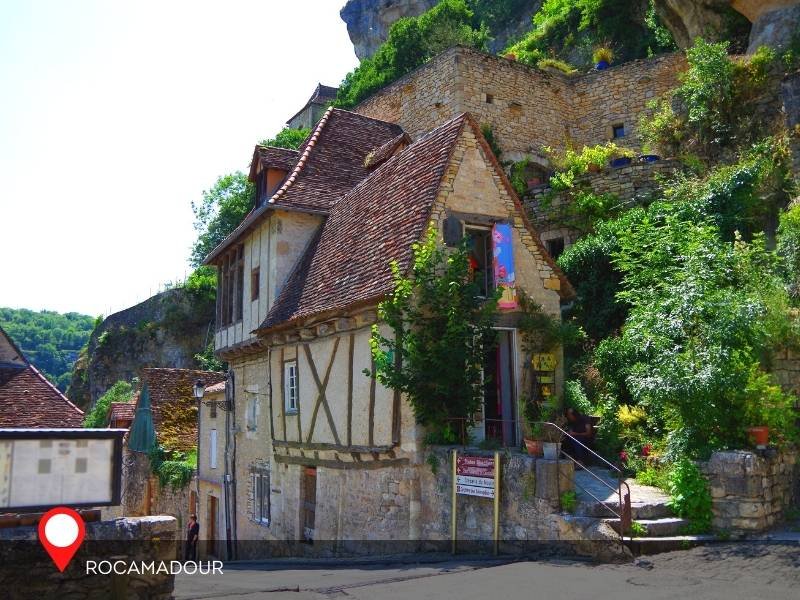
For wanderers, photographers, architecture enthusiasts, and old souls, I’m sure Cité Médiévale is the primary reason they’ll visit Rocamadour. I know because I’m one of them. That’s why I love writing about places like Rocamadour!
Places like Cité Médiévale let you see a kind of beauty that’s not so common nowadays, providing a sense of escapism. How good is it to forget our “reality, problems, and worries” for a while? It’s escapism, and I think you also love that!
You will already feel this sense of escapism before entering Cité Médiévale, right along the “Sacred Way.” This is thanks to a breathtaking view of Cité Médiévale from the path, plus the quaint houses built along the sides.
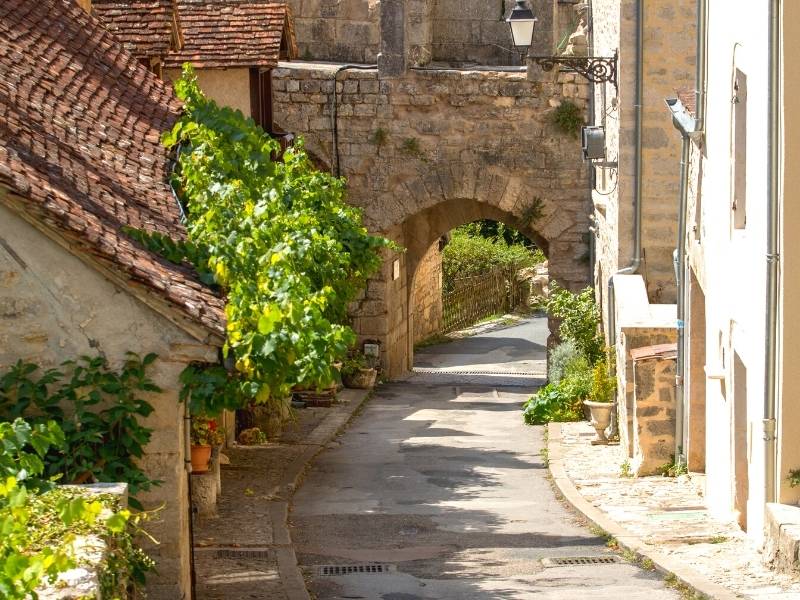
The Sacred Way is the pedestrian path that connects l’Hospitalet to Cité Médiévale (labeled Au Fond de la côte in Google Maps.)
Upon entering Cité Médiévale, you’ll feel as if you’ve stepped back in time, far from the 21st century. Why? Because it’s a car-free zone, and the structures appear as if they’re straight out of a movie set in the Middle Ages!
As you stroll along the village’s main streets, Rue de la Couronnerie and Rue Roland le Preux, you won’t see skyscrapers piercing the sky. Instead, you’ll find the Bishop’s Castle perched at the clifftop. That’s the view that greets you when you look up while meandering through the village.

If you have a lot of free time, you can challenge yourself to find all seven gates of Cité Médiévale. Here are their names and clues about where you can find them:
- Porte Hugon (The Hugon gate) – gate near Rocamadour Village intersection
- Porte Basse (The Lower gate) – along the village main street
- Porte Salmon or (The Salmon gate) – another gate along the village’s main street
- Porte Cabilliere (Cabilliere gate) – village’s southernmost gate
- Porte du Figuier (The Fig-Tree gate) – entrance from Sacred Way from l’Hospitalet Village
- Porte Saint-Martial (Saint-Martial gate) – gateway to the Sanctuaries.
- Porte Sainte (Holy door) – passage to Chemin de Ronde from the Sanctuaries
Near the southernmost part of Cité Médiévale, along its main street, you can find the 216-step Great Staircase of Rocamadour. This is where pilgrims begin their act of repentance before venerating the Black Madonna.
Interestingly, pilgrims during the Middle Ages used to climb the stairs on their knees. However, this practice is now discouraged. Whether you’re a pilgrim or not, you may ascend using your feet, but it’s recommended to do so with reverence.
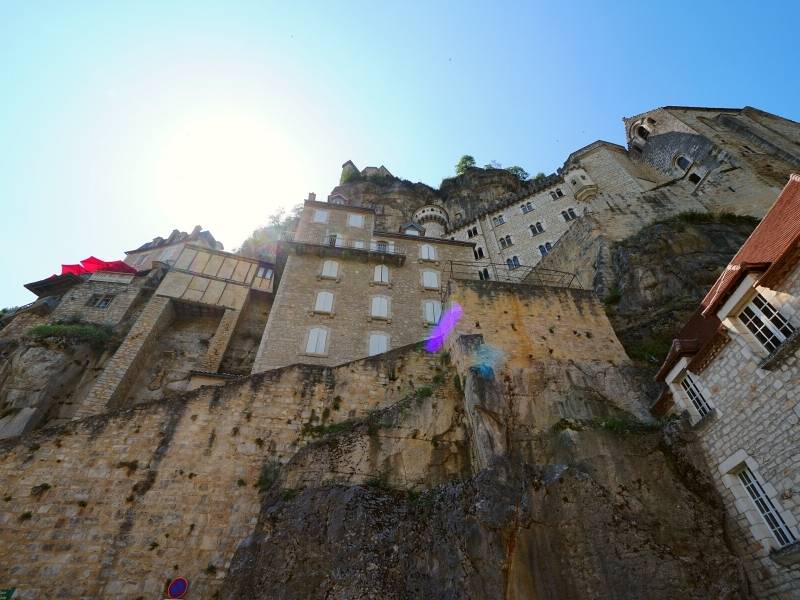
Tip: Cité Médiévale main street and the Sanctuaries are connected by the Great staircase and an elevator. See the map to find the locations of the elevators in Rocamadour.
By the way, if you’re seeking escapism, a chance to escape from life without letting life escape from you, then the fairytale town of Colmar is a must-see.
5. Discover Rocamadour’s Historical Landmarks — Palace, Shrine, Grottos
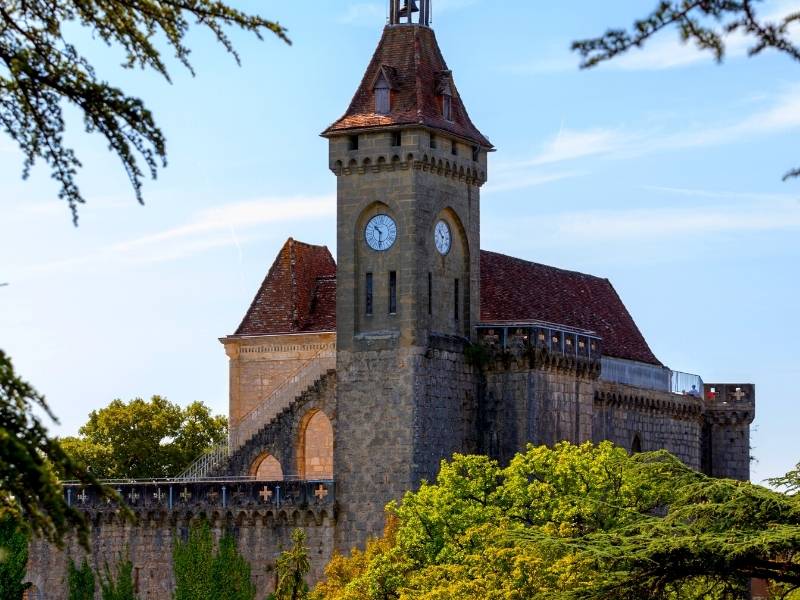
The spiritual and historical attractions, as well as the beautiful experiences in Rocamadour, extend to the top of the cliff above the Sanctuaries and Cité Médiévale. If you’re looking for a destination with lots to do, Rocamadour won’t disappoint!
Overlooking the Cité Médiévale and the Sanctuaries, you’ll find the Castle of Rocamadour (Château de Rocamadour), which was built to protect the Sanctuaries below it. Constructed in the 14th century, the castle has undergone several modifications over time.
The two ramparts of Château de Rocamadour bear witness to these modifications. They were once connected, allowing medieval guards to move freely from one end to the other. You can enter the ramparts and walk on top if you wish. Pretend that you’re one of the medieval guards spotting enemies approaching Rocamadour!
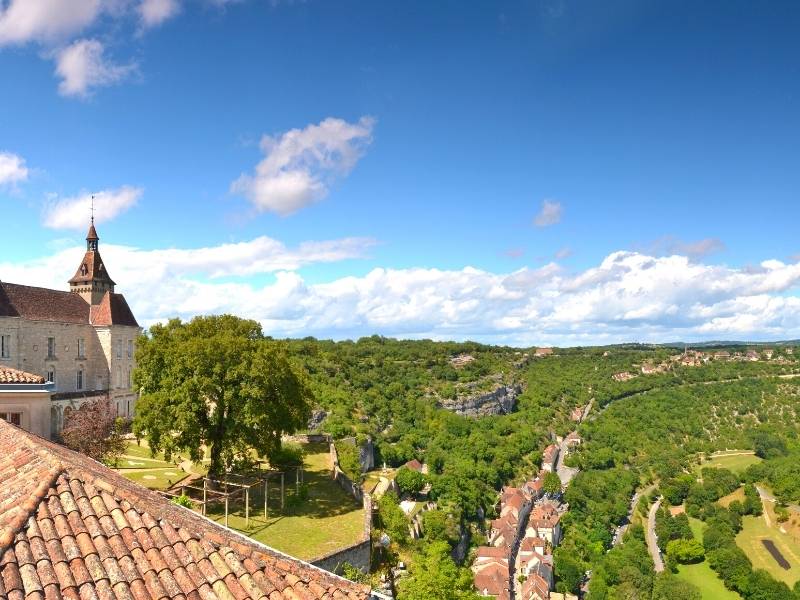

From the top, you’ll be treated to even more scenic views of the Alzou valley. Personally, I find the view of the Alzou valley from above quite spectacular, with the white limestones forming the edges of the forested valley. Of course, the view from the ramparts of Château de Rocamadour includes the Cité Médiévale and the Sanctuaries!
Château de Rocamadour is open all year round. You can enter the ramparts from 8:00 am to 8:00 pm for an admission fee of 2 EUR per adult.
If you’re currently in Cité Médiévale and wondering how to get to Château de Rocamadour, you have two options. You can either use the elevators or walk. You can refer back to the maps I showed you to see where the elevators in Rocamadour are located. Alternatively, you can check their exact location on Google Maps using this link.
However, if you want to get to Château de Rocamadour from Cité Médiévale on foot, you must first get to the Sanctuaries’ parvis via the Great Staircase. Then, you should find and enter a portal labeled “Chemin de Croix” (Way of the Cross) in the Parvis (Porte Saint-Martial). Chemin de Croix is an inclined path to the top of the cliff that links the Sanctuaries and Château de Rocamadour.

If you’re unfamiliar with the story of the Passion of Jesus, Chemin de Croix has shrines that can provide insights into this and into the faith of Christians. Pilgrims sometimes stop at each shrine to meditate and pray.
Also, in Chemin de Croix, you’ll find a quarry built like a temple that depicts the image of Christ after His death on the cross. This cave is called Grotte du Saint-Sépulcre, signaling that the Way of the Cross is almost finished.
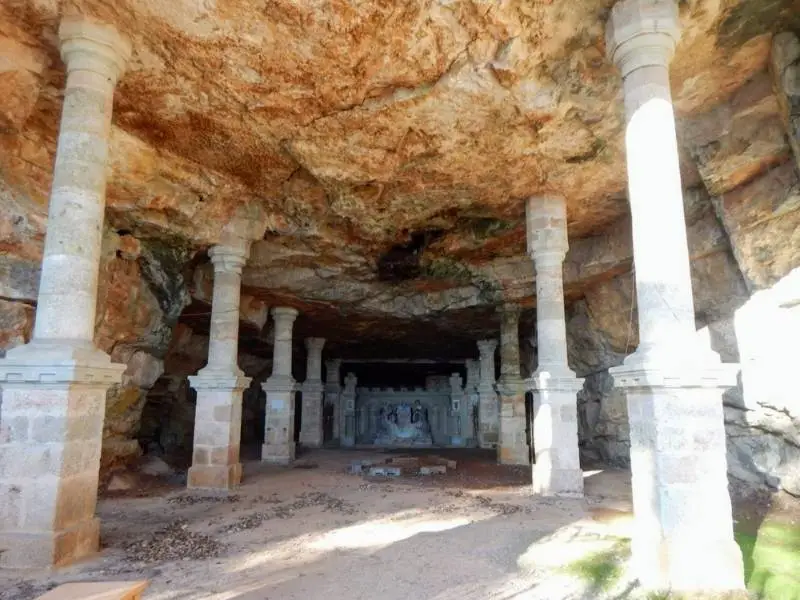
At the end of Chemin de Croix, the Cross of Jerusalem awaits you. This beautiful cross is embellished with curvy metals, said to have been brought to Rocamadour from Israel by pilgrims. You can go behind the Cross of Jerusalem to see breathtaking views of the Alzou valley.

Rocamadour is home to many religious landmarks. If these are the types of landmarks you’re interested in seeing in France, then you must visit Reims. The cathedral in Reims is where the kings of France were crowned for many generations.
6. Behold Rocamadour’s Breathtaking Sceneries — Time-Transporting Viewpoints
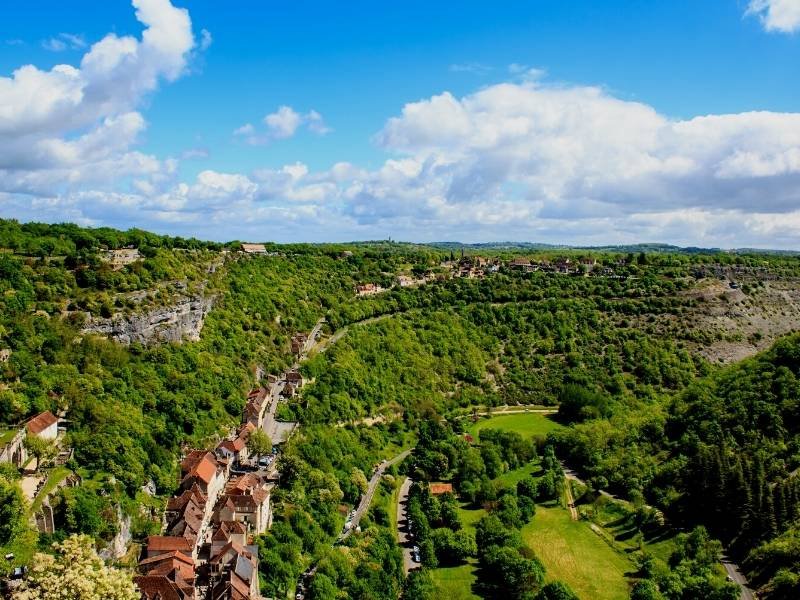
While the views from the Château de Rocamadour, the Cross of Jerusalem, and the balcony of the Sanctuaries are indeed scenic, they’re not the only places where you can find such beauty. In fact, the views from other parts of Rocamadour are even more stunning, especially when the Cité Médiévale and Château de Rocamadour are visible from these vantage points.
For me, these awe-inspiring views are one of the best reasons to visit Rocamadour. The vantage points in Rocamadour are best visited during the Golden Hour, which is perfect timing just after you’ve explored the Cité Médiévale, Sanctuaries, and Château de Rocamadour during the day.
I won’t keep you in suspense any longer. Here are the three vantage points you must visit when in Rocamadour (click the links to see the exact locations on Google Maps):
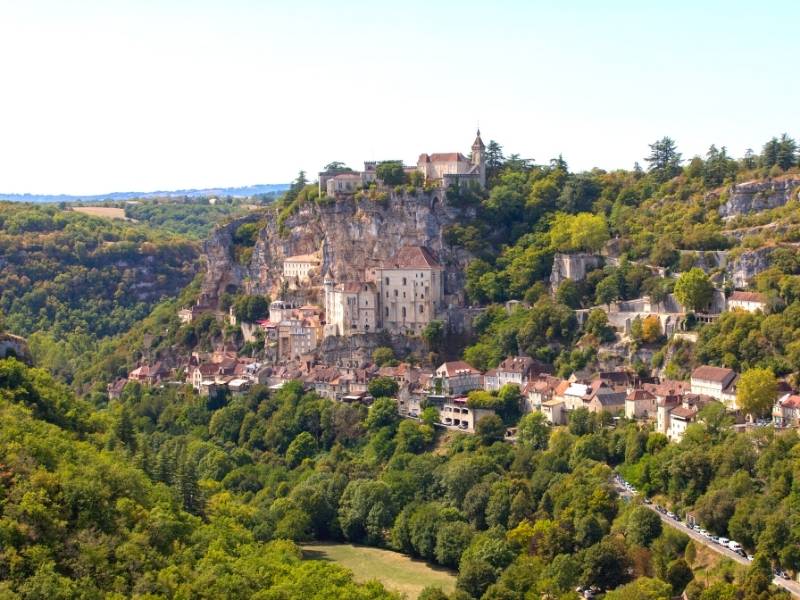
Among the three vantage points of Rocamadour, the one in the hamlet of l’Hospitalet is the most accessible. However, it is also the farthest from Cité Médiévale.
The vantage point in l’Hospitalet is also one of the best spots to watch the Hot Air Balloon festival in Rocamadour. This festival takes place every last weekend of September. During this time, more or less 30 hot air balloons rise from the Alzou valley, making Rocamadour look even more fantastic.
The vantage point of Cité Médiévale is near the Hôtel Restaurant Le Belvédère. From here, you should be able to see a stunning view of Cité Médiévale, just a few minutes’ walk from the parking lot in l’Hospitalet.
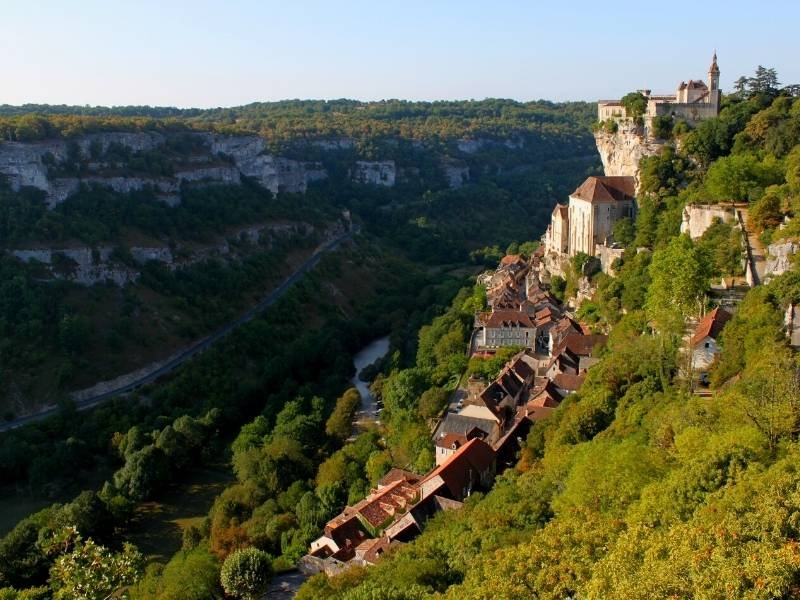
Le Coin Du Photographe, or the Photographer’s Corner, is the next accessible vantage point of Rocamadour. It’s located between Cité Médiévale and l’Hospitalet, along the Les Esclargies road. The Photographer’s Corner is the best spot to see Chateau de Rocamadour perched prominently above the Cité Médiévale.
From here, you’ll see how narrow Cité Médiévale is and how spectacularly it’s built on the cliffside. You can reach the Photographer’s Corner of Rocamadour within less than 10 minutes of walking or 5 minutes of driving from l’Hospitalet or Château de Rocamadour. This vantage point has its own parking space, so you don’t have to worry about parking along the road.
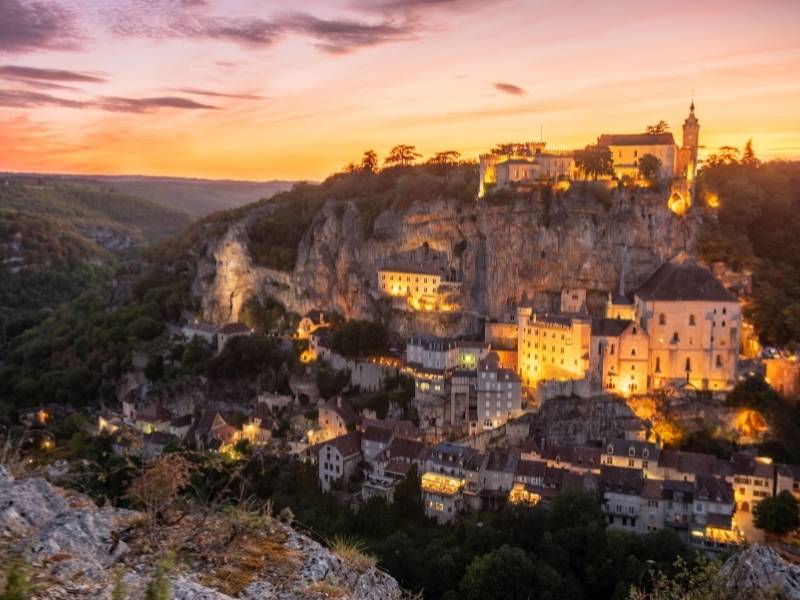
Croix de Cufelle, the viewpoint in Rocamadour that’s across the Alzou valley from Cité Médiévale/l’Hospitalet, requires some hiking to reach. If you have hiking experience, you can get to Croix de Cufelle within 30 minutes from P5.
Here is the map to further guide you with direction:
The view of Cité Médiévale from Croix de Cufelle is entirely unique compared to the first two vantage points mentioned. From here, you’ll see an almost perpendicular view of Cité Médiévale.
However, the hiking trail to Croix de Cufelle isn’t well established, and there are no markings yet. It’s advisable to use GPS, Komoot, or Google Maps for navigation. Here’s some advice from Google Maps:
Great view of the city and worth the short hike. The way is not marked on maps. Park in P5 and then walk towards the city. Cross over the bridge and follow the path up the hill on the other side. The way into the path is fairly hidden. When you see a stone wall 5 meters on your right, look left and walk down a stoney way. You will know you are on the right path when you see red marks on the rock. The rest of the way is marked with these red marks. Don’t try and shortcut up the hill. It is very slippery and loose footing. Enjoy.
Tom Sheridan
If you’re in search of a city with scenic views, Lyon should be on your list. Its beautiful church is perched on a hilltop, overlooking the town. The panoramic view from the top of the church’s tower is breathtaking, and on a clear, sunny day, you can even see the French Alps.
7. Watch Equestrian Show at Parc Durandal near Rocamadour
From the ramparts of Château de Rocamadour and the vantage points we discussed previously, you can only spot small villages, hills, and forests nearby. This will make you realize that despite the region’s thousand-year history, Rocamadour remains a countryside.
In a way, it’s a refreshing sight, especially in the summer when the surrounding forests are lush and verdant. It could be the view you’re looking for if you’re tired of city life.
However, did you know that Rocamadour offers an extraordinary countryside experience? You can find this at Parc Durandal. This is one of Rocamadour’s theme parks, which I believe is another reason to visit Rocamadour.
Parc Durandal is a medieval theme park filled with farm animals, horses, blacksmiths, and huts. Pony rides are also available! A visit to Rocamadour’s Parc Durandal will make you feel as if you’ve stepped away from the city and traveled back to the middle ages.
What sets Parc Durandal apart are their medieval plays, which feature spectacular equestrian stunts and fights. The performances are infused with amusing off-beat humor, making the experience incredibly enjoyable. The last time I checked, they were portraying the life of Roland, the bearer of the legendary Durandal Sword. However, they change the theme according to the season.
The characters are dressed in full-medieval attire, complete with real swords and metal armors. If you’re a fan of movies set in the middle ages, you’ll love watching their plays! Although the presentation is in French, the storyline is simple enough to follow, even if you only speak English or your native language. The humor and thrilling action serve as the main entertaining factors, ensuring you’ll enjoy the show.
Before your visit, make sure to check the Parc Durandal schedule announcements on their official website. The page is in French, so you might need a browser with a translation function to read it in English. Parc Durandal is conveniently located just a few minutes’ walk from Château de Rocamadour. I recommend visiting Parc Durandal after Cité Médiévale for a continuous time-traveling experience.
8. See Spectacular Birds Performances in Rocher des Aigles Near Rocamadour

Just a few steps west of Parc Durandal in Rocamadour, you’ll find Rocher des Aigles. This place offers even more spectacular shows! If you’re an animal lover, specifically birds, Rocher des Aigles is a must-visit.
Essentially, Rocher des Aigles is an ornithological park dedicated to the protection of birds of prey. It’s an institution that promotes animal welfare, raises awareness, and develops sustainability programs for these birds.
The staff at Rocher des Aigles are involved in breeding and training birds of prey. They also educate visitors about the importance of preserving these birds.
During your visit to Rocher des Aigles, you’ll learn about various birds such as falcons, owls, parrots, eagles, cockatoos, chimangos, and more. The learning experience is far from a dull museum visit. It’s more like a zoo with large aviaries that mimic the birds’ natural habitats.
You’ll get to meet these beautiful birds and learn about them through the information boards along the trail. Yes, there’s a trail at Rocher des Aigles that takes you on a journey through the lives of the park’s birds. The trail begins in the breeding rooms, where you can see adorable newborn chicks. It ends with a presentation of the birds, which is an unmissable experience in Rocamadour.
This final part might remind you of the cartoon show Pokemon. But don’t worry, there won’t be any bird fights! You’ll understand what I mean when you see the trainer commanding the bird to fly and perform tricks. You’ll be amazed by the Art of Falconry performed during the presentation.
In fact, this Art of Falconry is listed in UNESCO’s World Intangible Cultural Heritage. If you’re lucky, you might witness a peregrine falcon, the world’s fastest animal, in action.
Are you considering a visit to Rocher des Aigles in Rocamadour? Rocher des Aigles is open daily from April 1 to September 30. However, the opening hours can vary. Rest assured, bird performances are scheduled at 2:30 pm and 4:00 pm throughout the summer season. The entry fee is 11 EUR per adult.
I recommend checking the Rocher des Aigles website before your visit. You’ll find all the necessary visiting information there.
9. Play with The Monkeys in the Monkey Forest of Rocamadour

Rocamadour’s location within the country is another factor that makes it worth visiting. Although Rocamadour is quite a distance from the major cities in France, making it somewhat challenging to reach, the area within and around Rocamadour is simply fantastic!
Situated at the heart of the Causses du Quercy Natural Regional Park, Rocamadour offers breathtaking vistas and wildlife encounters. In addition to the Birds of Prey and their incredible shows at Rocher des Aigles, you can also meet adorable monkeys in Rocamadour.
These monkeys have their own forest, known as La Forêt des Singes or Monkey Forest. This unique attraction adds to the charm and appeal of Rocamadour.
La Forêt des Singes, like Rocher des Aigles, is dedicated to animal preservation. However, instead of birds, this institution focuses on monkeys, specifically Barbary macaques.
Barbary macaque monkeys are primarily located in the Atlas Mountains of Algeria. They can also be found in certain regions of Morocco and Gibraltar.
La Forêt des Singes is involved in ethological research on Barbary macaques. It raises public awareness and reintroduces these monkeys to their original habitats. The institution has extensive knowledge about Barbary macaques, having studied these monkeys since 1974.
During your visit to La Forêt des Singes, guides will accompany you and share fascinating facts about Barbary macaques. This information is typically shared during the feeding sessions of the Barbary macaques, which occur every 45 minutes.
Of course, you’ll see Barbary macaque monkeys during your visit! There are more than 150 Barbary macaques in La Forêt des Singes, and they roam freely around the vast 20-hectare forest. Sometimes, they may even approach you and perform amusing antics, such as stealing your snacks!
Visitors typically complete the 1.3-kilometer trail in La Forêt des Singes within 1.5 hours. A visit to La Forêt des Singes is a great idea when the weather is fine. Not only will you see a unique species of monkeys, but you’ll also have the opportunity to immerse yourself in nature.
La Forêt des Singes is open daily from the last week of March until early November. The park operates on irregular hours, but it is consistently open from 1:30 pm to 5:00 pm.
The entrance fee is 9.5 EUR per adult. It is recommended to review the practical information provided on the official website of La Forêt des Singes before your visit. All necessary details are provided on the page.
La Forêt des Singes is located to the east of the Rocamadour hamlet of l’Hospitalet. It is a brief 7-to-10-minute walk from the Rocamadour viewpoint in l’Hospitalet.
10. Visit Spectacular Caves Around Rocamadour

As previously mentioned, Rocamadour’s location, aside from its historical significance, makes it a worthwhile visit. Nestled in the heart of Causses du Quercy Natural Regional Park, Rocamadour provides easy access to numerous spectacular caves.
Believe it or not, there’s even a prehistoric cave in the hamlet of l’Hospitalet! If you’re a nature enthusiast and the prospect of exploring underground beauty and mystery excites you, these caves in and around Rocamadour could be your motivation to visit.
Among all the captivating caves in Causses du Quercy Natural Regional Park, the three closest to Rocamadour are:
- Grotte Préhistorique des Merveilles
- Grottes de Lacave
- Gouffre de Padirac
You might need to rent a car to visit two of the attractions from Rocamadour. Let’s discuss each one.
The first underground wonder in Rocamadour is the Grotte Préhistorique des Merveilles. This cave is located in the hamlet of l’Hospitalet, just a three-minute walk northwest of the Cité Médiévale vantage point.
As its name suggests, the Grotte Préhistorique des Merveilles is a cave that provides evidence of prehistoric activities. Inside, you’ll find spectacular stalagmites and stalactites. What makes it truly fascinating, however, are the markings and paintings on the cave’s rock formations. These date back to the Gravettian period, which is between 33,000 and 21,000 years before present!
The Grotte Préhistorique des Merveilles can be considered a hidden gem in l’Hospitalet. In a sense, it’s literally hidden behind the houses in the hamlet. However, it’s not hard to find as it now has a visible landmark.
The Grotte Préhistorique des Merveilles is a relatively small cave, with tours lasting only 45 minutes. The entry fee is 8 EUR per adult. While the opening hours of the Grotte Préhistorique des Merveilles are irregular, it should be accessible from the second week of April to September, from 10:30 am to 4:15 pm. For complete information, it is recommended to check the official website of the Grotte Préhistorique des Merveilles.
Visiting Rocamadour and exploring these caves will make you realize that Mother Nature is truly the “greatest artist.” This sentiment will resonate with you when you enter the Grottes de Lacave, an awe-inspiring cave located a 15-to-17-minute drive northwest of Rocamadour.
The Grottes de Lacave is a 150-million-year-old geological wonder, housing incredible rock formations. It is akin to a gallery of otherworldly natural sculptures. The stalagmites and stalactites resemble waves of mud and earth tentacles, frozen spectacularly in time. As the rock formations are illuminated by light installations, their reflections shimmer on the underground lake below. The scenery is so compelling that you’ll be tempted to take pictures (please, no flash).
The most beautiful and unmissable part of the Grottes de Lacave is the cavern lit with ultraviolet light. The entire place is phosphorescent, providing a jaw-dropping, magical experience.
Take a glimpse at the view inside Grottes de Lacave:
The Grottes de Lacave has varying opening hours each month. At the very least, the Grottes de Lacave is open from the second week of February to the second week of November, between 10:00 am and 5:00 pm. The entry fee is 12 EUR per adult. For complete visiting information, please check the official website of Grottes de Lacave.
Last but not least, among the three caves easily accessible from Rocamadour, Gouffre de Padirac is the furthest from the pilgrimage village. It takes a 25-minute drive from l’Hospitalet or Rocamadour to reach Gouffre de Padirac.
However, don’t let the distance deter you from visiting Gouffre de Padirac! It is one of the most renowned caves not only in Rocamadour and Causses du Quercy, but perhaps in all of France. Interestingly, Gouffre de Padirac attracts 400,000 visitors annually.
Like Grottes de Lacave, Gouffre de Padirac is filled with stunning rock formations. The cauliflower-shaped and Saracen’s Tent stalactites are the two most spectacular formations inside Gouffre de Padirac, and they are sure to leave you in awe.
The term “gouffre” is French and translates to “chasm” in English. This gives you a hint about what makes Gouffre de Padirac special. Indeed, it is a chasm like no other in France. It is a circular chasm that opens into its cave system 103 meters (338 feet) below its 33-meter diameter (108 feet) mouth. Some even refer to Gouffre de Padirac as “one of the most extraordinary natural phenomena of the Massif Central.”
The cave also features a subterranean river system where you can enjoy a boat ride, passing through various underground wonders.
Gouffre de Padirac operates on irregular hours. However, it is typically open from 10:00 am to 4:30 pm from April until the second week of November. Please note that entry passes can only be obtained by booking online.
Is Rocamadour a UNESCO site?
With all the preserved, historical, religious, and culture-filled buildings in Rocamadour, one might wonder: Is Rocamadour a UNESCO site? The answer is both yes and no. Rocamadour itself is not a UNESCO site. However, Rocamadour does have a historical structure that is part of a broader UNESCO site called the “Routes of Santiago de Compostela in France.”
The historical structure in Rocamadour included in the Routes of Santiago de Compostela in France UNESCO site is the Basilique Saint-Sauveur et crypte Saint-Amadour, located in Rocamadour’s Sanctuaries.
If you’re in search of a city that boasts a UNESCO site, Strasbourg should be at the top of your list. As the capital of Europe, it offers a UNESCO-designated historical district, enchanting locales that seem straight out of a fairytale, and awe-inspiring modern structures—all ready to satiate your travel cravings!
How to Get to Rocamadour
Rocamadour is located in Southwestern France, specifically in the Lot Department of the Northern Occitania Region. It’s perched on a cliff within the Parc Naturel Régional des Causses du Quercy, providing stunning views of the Alzou valley.
If you’re traveling from abroad, you’ll likely need to fly into a city in France. The nearest cities with international flight connections are Toulouse and Bordeaux. Rocamadour is a 2-hour drive from Toulouse and a 2.5-hour drive from Bordeaux.
If you choose to use public transit, the journey from either city to Rocamadour-Padirac, and then on to Rocamadour, can take between 4 to 5 hours. Unfortunately, there are no direct train services from major cities to Rocamadour. The closest station is Rocamadour – Padirac. From there, you’ll need to take a bus (#877 or #876) to reach the main attraction in Rocamadour.
While it’s possible to visit Rocamadour in a day, I’d recommend staying overnight, especially if you’re relying on public transit. If you’re already in a nearby town, such as Sarlat, you might want to consider taking a tour. There are tours available that include both Rocamadour and the Paridac Chasm. For more information, check out this list of tours in Rocamadour.
Best Time to Visit Rocamadour
The ideal time to visit Rocamadour largely hinges on the activities you wish to prioritize during your stay. If you’re visiting Rocamadour as a pilgrim, it’s a year-round destination. However, if you’re also interested in experiencing Rocamadour as a tourist, the summer months of July and August might be more ideal.
During this period, you can anticipate warm days with temperatures around 27°C (81°F), and cooler nights with temperatures ranging from 15°C (60°F) to 16°C (60°F). Additionally, there’s an abundance of sunshine, averaging 9 hours per day, and only about 8 days of rain per month. This summer weather in Rocamadour is ideal for exploration and sightseeing.
The summer season also offers a variety of outdoor activities around the village, such as watching performances at Rocher des Aigles or Parc Durandal. However, keep in mind that summer is the peak season, so be prepared for crowds.
If you prefer a quieter visit, consider the shoulder seasons of May to June and September to October. In May and June, you can expect average high temperatures of around 21°C (70°F) and 26°C (79°F) respectively. In September and October, the weather remains quite pleasant, with average highs of about 25°C (77°F) in September, and cooler temperatures around 19°C (66°F) in October.
For a unique experience, consider visiting Rocamadour during the last weekend of September when the Annual Hot Air Balloon Festival takes place.
How Many Days in Rocamadour
Rocamadour is a quaint village that can be explored in half a day. This includes visiting the sanctuaries, wandering through the medieval village, and stopping by some of Rocamadour’s viewpoints. If you’re traveling from Toulouse or Bordeaux by car, a day trip to Rocamadour is quite feasible.
However, to fully appreciate Rocamadour, a two-day stay is recommended. This allows time to discover its side attractions, which are equally worthwhile. An extended stay also offers perks such as witnessing the golden hour in this picturesque village, be it at sunrise or sunset. For photographers, this is a moment not to be missed!
Spending two days in Rocamadour also provides an opportunity to immerse yourself in the village’s stunning heritage at a leisurely pace. In the late afternoon, once the day-trippers have departed, Rocamadour transforms into an even more sacred and spectacular village – quiet and serene.
If you plan to stay in Rocamadour for two or more days, here is where you can find the best hotel deals in Rocamadour.
Places Similar to Rocamadour
If you’re seeking unique, beautiful, and less-traveled destinations in southern France, similar to Rocamadour, there are plenty more to choose from. My recommendation? Consider visiting the 10 most beautiful villages in the South of France (Rocamadour is one of them).
These 10 villages can be categorized into three groups, each offering a unique experience.
For a journey that allows you to delve into fascinating history and marvel at stunning architecture, Carcassonne, Aigues-Mortes, and Domme are must-visit destinations. These villages are known for their impressive medieval defenses and the ingenuity of their fortifications.
If you’re drawn to romantic hilltop villages, Eze, Saint-Paul-de-Vence, Gordes, and Saint-Cirq-Lapopie are the ones to see. Their quaint streets are perfect for leisurely strolls and photo opportunities.
Lastly, Chamonix and Moustiers-Sainte-Marie are particularly special. Not only are these villages visually appealing, but they also offer adventures amidst breathtaking natural attractions. To give you an idea, Chamonix is nestled in the French Alps, while Moustiers-Sainte-Marie is located in the Verdon Natural Regional Park.
That concludes our discussion about Rocamadour. I hope you found it enjoyable to read. If you have any thoughts or questions, please feel free to leave a comment below. Wishing you a wonderful trip!
Save it on Pinterest.





